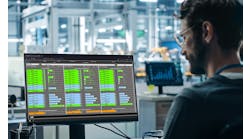Heading into 2019, manufacturers will need to continue confronting new consumer expectations and preferences. People want the latest product, produced at the highest quality, in some cases customized just for them, at a reasonable price. And, by the way, they want it now.
If I had to summarize the next year in five predictions, I would say that 2019 will be the year that any remaining skepticism concerning automation and digitalization will give way to a more bullish—and less abstract—view of the Industrial Internet of Things (IIoT). This is the moment to put purpose to data, invest in the workforce, and deploy artificial intelligence.
1. Manufacturing sector in the U.S. will continue to expand
For U.S. manufacturing, 2018 was a phenomenal year. The Wall Street Journal reported in August that U.S. factories were “firing on all cylinders,” with new orders, production and employment improving “sharply.” Manufacturers added hundreds of thousands of jobs and now create some $6 trillion in gross output. The 13 million people working in manufacturing are also expressing historically high levels of optimism about the future.
According to MAPI, U.S. manufacturing production is predicted to increase by 2.8% for the 2018-2021 period.
2. Digitalization will continue to be a hot topic for manufacturers
Factories will continue to move to becoming fully automated and the advances and use of AI will help machines understand more complex tasks. Modernization through advanced automation and digitalization will remain key for companies to maintain competitiveness within the market. Digitalization will pick the winners and losers in manufacturing.
For its part, Siemens will invest $500 million over the next three years to develop two IoT facilities in the United Arabs Emirates—one in Dubai and another Abu Dhabi—to push more efficient energy and supply chain solutions based on its cloud-based MindSphere platform.
3. This will be the year of digital action for small to mid-size businesses
As digitalization increasingly impacts the industry, we will see more and more small and medium size businesses digitalizing their operations. We won’t see the same blueprint for digitalizing production within an organization, but will see most gradually modernizing their operations.
The most successful and streamlined transitions will only happen when production resources systematically implement a fully integrated solution verses consuming energy attempting to connect individual components.
4. More industry-based standards will arise in the cyber space to protect industry
More cyberattacks against the industrial sector are inevitable, threatening to impact operations, create financial losses and put lives at risk. In 2016, these attacks cost $564 billion in damages around the world. And the attack surface will expand greatly over the next year. An estimated 20.4 billion devices will be connected in 2020, or 2.5 times the amount in 2017.
Technology will lead the way, as companies employ sophisticated systems to increase visibility and monitor assets. But for digitalization to advance, there must be trust within vast ecosystems.
Initiatives like the Charter of Trust will advance the dialogue globally to address a common framework to reduce the cyber risk.
5. Manufacturers will attract the next generation of workers
Pressure will remain around the skills gap shortage. But the bigger question is: How do we inspire people to pursue manufacturing as a career?
Digitalization can not only set you apart in production but also in regards to recruiting employees. And as companies transform their operations and lead the digital transformation, they must also focus on people through recruiting and training current and aspiring employees. A dangerous inhibitor comes from those current leaders holding on to status quo, attempting to avoid personal change.
As millennials see that digital technology and software are the future. The time is now to rebrand digital manufacturing as the place to be – and that’s an important prediction to end on.
*Bonus Prediction: Optimism on the Horizon
Digital technology does not replace human capability; it elevates human knowledge and skills. From data analytics to artificial intelligence, the future factory floor gives workers new tools that enable them to produce better products and even make their jobs more satisfying.
We should then think about what we can do as an industry if we can bring together a new generation of workers who are passionate about digital technology, data, and software with veteran employees who are in possession of deep industry domain knowledge. I'm willing to predict this will position manufacturing to continue thriving and evolving in the 21st century.










